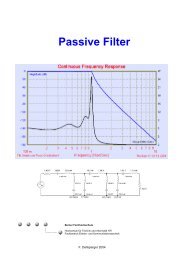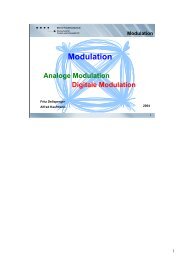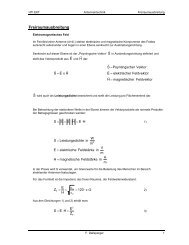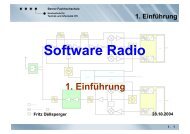Help for Smith V3.10 - Fritz Dellsperger
Help for Smith V3.10 - Fritz Dellsperger
Help for Smith V3.10 - Fritz Dellsperger
Create successful ePaper yourself
Turn your PDF publications into a flip-book with our unique Google optimized e-Paper software.
CITI<br />
(Text adopted from Agilent)<br />
Overview<br />
CITIfile is a standardized data <strong>for</strong>mat that is used <strong>for</strong> exchanging data between different computers<br />
and instruments. CITIfile stands <strong>for</strong> Common Instrumentation Transfer and Interchange file <strong>for</strong>mat.<br />
CITIfile defines how the data inside an ASCII package is <strong>for</strong>matted. Since it is not tied to any particular<br />
disk or transfer <strong>for</strong>mat, it can be used with any operating system, such as DOS or UNIX, with any disk<br />
<strong>for</strong>mat, such as DOS or HFS, or with any transfer mechanism, such as by disk, LAN, or GPIB.<br />
By careful implementation of the standard, instruments and software packages using CITIfile are able<br />
to load and work with data created on another instrument or computer. It is possible, <strong>for</strong> example, <strong>for</strong> a<br />
network analyzer to directly load and display data measured on a scalar analyzer, or <strong>for</strong> a software<br />
package running on a computer to read data measured on the network analyzer.<br />
Data Formats<br />
CITIfile uses the ASCII text <strong>for</strong>mat.<br />
The ASCII <strong>for</strong>mat is accepted by most text editors. This allows files to be created, examined, and<br />
edited easily, making CITIfile easy to test and debug.<br />
CITIfile Definitions<br />
This section defines: package, header, data array, and keyword.<br />
Package<br />
A typical CITIfile package is divided into two parts:<br />
� The header is made up of keywords and setup in<strong>for</strong>mation.<br />
� The data usually consists of one or more arrays of data.<br />
The following example shows the basic structure of a CITIfile package:<br />
When stored in a file there may be more than one CITIfile package. With the Agilent 8510 network<br />
analyzer, <strong>for</strong> example, storing a memory all will save all eight of the memories held in the instrument.<br />
This results in a single file that contains eight CITIfile packages.<br />
Header<br />
The header section contains in<strong>for</strong>mation about the data that will follow. It may also include in<strong>for</strong>mation<br />
about the setup of the instrument that measured the data. The CITIfile header shown in the first<br />
example has the minimum of in<strong>for</strong>mation necessary; no instrument setup in<strong>for</strong>mation was included.<br />
Data Array<br />
An array is numeric data that is arranged with one data element per line. A CITIfile package may<br />
contain more than one array of data. Arrays of data start after the BEGIN keyword, and the END<br />
keyword follows the last data element in an array.<br />
A CITIfile package does not necessarily need to include data arrays. For instance, CITIfile could be<br />
used to store the current state of an instrument. In that case the keywords VAR, BEGIN, and END<br />
would not be required.<br />
When accessing arrays via the DAC (DataAccessComponent), the simulator requires array elements<br />
to be listed completely and in order.<br />
Example: S[1,1], S[1,2], S[2,1], S[2,2]<br />
Keywords<br />
Keywords are always the first word on a new line. They are always one continuous word without<br />
embedded spaces.<br />
67






